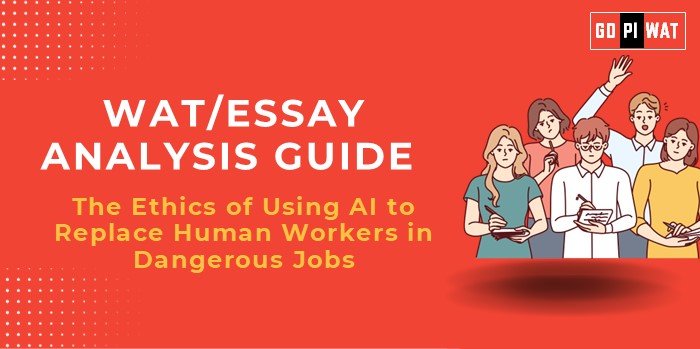📋 Written Ability Test (WAT)/Essay Analysis Guide
Topic: The Ethics of Using AI to Replace Human Workers in Dangerous Jobs
🌐 Understanding the Topic’s Importance
The rise of AI in hazardous jobs connects directly to global ethical, economic, and technological concerns. B-school candidates can leverage this topic to showcase critical thinking about automation’s impact on industries, labor, and society.
📝 Effective Planning and Writing
- Time Allocation:
- Planning: 5 minutes
- Writing: 20 minutes
- Review: 5 minutes
- Preparation Tips: Identify key stakeholders, gather data points (e.g., fatality reductions), and frame ethical considerations.
✒️ Introduction Techniques for Essays
- Contrast Approach: “While AI eliminates workplace hazards, its potential to displace millions demands careful ethical scrutiny.”
- Timeline Approach: “From its origins in assembly lines to life-saving roles in high-risk sectors, AI’s role in human safety has evolved alongside complex ethical questions.”
📂 Structuring the Essay Body
- Achievements: Highlight reduced fatalities, enhanced efficiency, and cost savings.
- Challenges: Discuss job displacement, ethical dilemmas, and reliability issues.
- Future Outlook: Recommend policies for ethical AI deployment and inclusive growth.
✅ Concluding Effectively
- Balanced Perspective: “While AI revolutionizes safety in hazardous jobs, ethical deployment demands an equitable approach to reskilling displaced workers.”
- Solution-Oriented Perspective: “AI in dangerous industries must prioritize both human safety and socioeconomic equity through robust policies.”
✨ Sample Short Essays (100 Words Each)
Balanced Perspective:
“AI’s integration into hazardous jobs highlights its potential to save lives and enhance efficiency. However, the ethical dilemmas surrounding job displacement and economic inequality demand careful consideration. Policies must focus on balancing technological progress with workforce inclusion, ensuring that AI adoption is both safe and equitable.”
Solution-Oriented Approach:
“AI’s capacity to reduce workplace fatalities is unmatched. To ensure equitable implementation, governments and corporations must collaborate on reskilling programs and ethical guidelines. Such initiatives would help mitigate the societal costs of job displacement while fostering a safer industrial ecosystem.”
Global Comparison:
“Countries like Norway demonstrate how AI can enhance safety in dangerous industries without sacrificing worker welfare. By investing in education and human-AI collaboration, other nations can follow suit, balancing technological adoption with ethical labor practices.”


